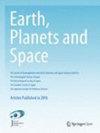Detection of hidden earthquakes after the 2011 Tohoku earthquake by automatic hypocenter determination combined with machine learning
IF 2.5
3区 地球科学
引用次数: 0
Abstract
Abstract After the 2011 M w 9.0 Tohoku earthquake, seismicity became extremely active throughout Japan. Despite enormous efforts to detect the large number of earthquakes, microearthquakes ( M < 2 inland, M < 3 offshore) were not always cataloged and many have remained undetected, making it difficult to understand the detailed seismicity after the 2011 Tohoku earthquake. We developed an automatic hypocenter determination method combined with machine learning to detect microearthquakes. Machine learning was used for phase classification with convolutional neural networks and ensemble learning to remove false detections. We detected > 920,000 earthquakes from March 2011 to February 2012, triple the number of the conventional earthquake catalog (~ 320,000). This represents a great improvement in earthquake detection, especially in and around the Tohoku region. Detailed analysis of our merged catalog more clearly revealed features such as (1) swarm migrations, (2) small foreshock activity, and (3) increased microseismicity preceding repeating earthquakes. This microseismic catalog provides a magnifying glass for understanding detailed seismicity. Graphical Abstract结合机器学习的自动震源确定方法在2011年东北地震后的隐藏地震检测
2011年日本东北9.0级地震发生后,整个日本的地震活动变得异常活跃。尽管人们付出了巨大的努力来探测大量的地震,但微地震(M <内陆,M <这些地震并不总是被记录在案,而且很多都没有被发现,这使得人们很难了解2011年日本东北地震后的详细地震活动。我们开发了一种结合机器学习的自动震源确定方法来检测微地震。使用机器学习与卷积神经网络和集成学习进行相位分类以去除假检测。我们检测到>2011年3月至2012年2月共发生92万次地震,是常规地震目录(~ 32万次)的三倍。这代表了地震探测的巨大进步,特别是在东北地区及其周边地区。对合并目录的详细分析更清楚地揭示了以下特征:(1)群迁移,(2)小前震活动,(3)重复地震前微震活动增加。这个微地震目录为了解详细的地震活动性提供了放大镜。图形抽象
本文章由计算机程序翻译,如有差异,请以英文原文为准。
求助全文
约1分钟内获得全文
求助全文
来源期刊

Earth, Planets and Space
地学天文-地球科学综合
CiteScore
5.80
自引率
16.70%
发文量
167
期刊介绍:
Earth, Planets and Space (EPS) covers scientific articles in Earth and Planetary Sciences, particularly geomagnetism, aeronomy, space science, seismology, volcanology, geodesy, and planetary science. EPS also welcomes articles in new and interdisciplinary subjects, including instrumentations. Only new and original contents will be accepted for publication.
 求助内容:
求助内容: 应助结果提醒方式:
应助结果提醒方式:


